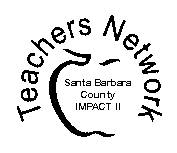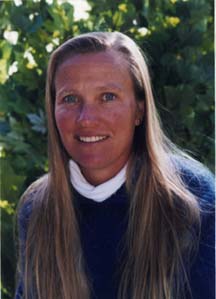The TeachNet Project sponsored with major funding by the AT&T Learning Network,
seeks to improve student achievement by providing training, grants, networking and resource sharing to teachers at four of the Teachers Network affiliates nationwide.

Funding Provided by Alias Wavefront
![]()
Let's Dance
How
it works:
Let's Dance is a unit where students
learn and choreograph dances over a three month period and then
perform their dance steps at an assembly. There are
approximately nine dances, and each dance goes with a different
piece of music. The music selections are about 30
seconds,
long and several genres of music are used incorporating varied
tempos and rhythmic patterns. The unit is recommended
to be taught either first thing in the morning after stretches
or during PE. Each dance is a different lesson, and
after it is taught the children practice it for
about a week before the new step is added to the routine.
One example of how media plays a role is
that during the process of creating the dances the children are
video taped. Then they watch the video and critique
the performance, and then apply what they learned to improve
their dances. In order to stay in compliance with
copyright laws, you can use small portions of different songs. You
capture the desired music pieces on your computer and burn a CD
with all nine songs to use at school. The dance is
also put onto a tape which is sold and showed at Open House at
the end of the school year. When a new dance is
taught, the children line up in the auditorium in a way that is
appropriate for the dance to be taught. The song is
played while they
just listen once. Then next time they clap to the
beat with my
guidance. Then the dance steps are taught with the
music off. Then we go over the step to the music. For
the next few days the children practice while the
teacher watches and gives suggestions. At least two
songs in the dance are open for the children to choreograph
their own movements.
These lessons take more time, because they
often need suggestions to get started. This is a good
time to go over the rubric and teach the vocabulary and specific
dance movements. There is a video tape of the
finished dance available .
Standards
Grade Two
1.0 Processing, Analyzing, and Responding to Sensory
Information
Through the Language and Skills Unique to Dance
Students perceive and respond, using the elements of dance. They
demonstrate movement skills, process sensory information, and
describe movement using the
vocabulary of dance.
Development of Motor Skills and Technical Expertise
1.1 Show a variety of combinations of basic locomotor skills
(e.g., walk and run, gallop and
jump, hop and skip, slide and roll).
1.2 Show a variety of combinations of axial movements (e.g.,
swing and balanced shapes, turn and stretch, bend and twist).
Comprehension and Analysis of Dance Elements
1.3 Perform short movement problems, emphasizing the element of
time (e.g., varied
tempos, rhythmic patterns, counting).
1.4 Expand the ability to incorporate spatial concepts in their
movement problems.
Development of Dance Vocabulary
1.5 Name a large number of locomotor and axial movements used in
dance.
2.0 Creating, Performing, and Participating in Dance
Students apply choreographic principles, processes, and skills
to create and communicate meaning through dance improvisation,
composition, and performance.
Creation/Invention of Dance Movement
2.1 Create and improvise movement patterns and sequences.
2.2 Demonstrate multiple solutions in response to a given
movement problem (e.g., How many ways can you travel from point
A to point B?)
Application of Choreographic Principles and Processes to
Creating Dance
2.3 Create a simple sequence of movement with a beginning, a
middle, and an end, incorporating level and directional changes.
2.4 Create shapes and movements, using fast and slow tempos.
2.5 Develop a dance phrase that has a sense of unity.
Communication of Meaning in Dance
2.6 Create, memorize, and perform original expressive movement
for peers.
Development of Partner and Group Skills
2.7 Work cooperatively in small and large groups.
2.8 Demonstrate partner skills (e.g., imitating and
leading/following).
4.0 Responding to, Analyzing, and Making Judgments About Works
of Dance
Students critically assess and derive meaning from works of
dance, performance of dancers, and original works based on the
elements of dance and aesthetic qualities.
Description, Analysis, and Criticism of Dance
4.1 Use basic dance vocabulary to name and d
describe a dance they have watched or
performed (e.g., levels, rhythm patterns, type of energy).
4.2 Describe how the movement in dances of peers communicates
ideas or moods to the
viewer (e.g., ocean environment or a sad or joyous dance).
Meaning and Impact of Dance
5.1 Use literature to inspire dance ideas (e.g., poem, cartoon,
nursery rhyme).
Estimated Class Periods to Complete
more than 10
Software and
Ma
It is very important and convenient to use
a CD for this dance unit. That requires using a CD ROM drive to
capture the segments of the songs that you want to use. You
can use Sound Edit 16, by Macromedia or iMovie by Apple or
something else. You make a folder and save all your
sound clips in that folder. Then once you have
digitized all the sound files, you use Adaptec's Toast to burn
a CD. You open Toast and drag your folder onto the
window. Then you burn the CD, and bring it to school. To
make the movie for Open House and/or student portfolios, you use
a video camera and then record your movie over to VHS to play on
the TV and VCR in your room. Video production
companies generally charge about $3.50 per video (if you buy 20)
to make copies to sell to parents. The more tapes you
copy, the lower the price goes. You can also use
iMove or Final Cut Pro or Adobe Premiere to edit the tape into
a polished professional piece of media. If you have a
digital video camera, you attach the camera into the firewire
port of your computer. Then you capture the segments that you
want to use into a library of clips. Then you
assemble the clips on a time line adding transitions, effects
and titles, if you want. When you are finished, you
render the movie on your computer and then print it to a VHS
tape by connecting the
VCR to your computer. On some cameras you go out from the
computer into your camera and then out from your camera to the
VCR. The camera's LCD
panel acts as your viewing monitor.
Keywords
dance, rubrics, final cut pro, imovie, elementary arts
The Students:
This unit can be taught to a large number
of students. It has been taught to a group of 2nd and
3rd graders for many years now (approximately 40 students). It's
about self expression and art, so it's suitable to all children. It's
a great chance for the kinesthetic kids to shine. This unit has
been a great source for class circles to discuss the issue of
"how you are smart" as opposed to "how smart are
you". Sometimes the linguistic and logical kids are
uncomfortable with dancing and we start a dialogue about
different ways to be intelligent.
Often kids will share their feelings about what subjects are
difficult for them and which ones are easy.
Overall Value:
Tips for the teacher:
This unit is very joy filled yet standards based. The
laughter and beauty involved with young children learning to
express themselves is wonderful. Dance and music add
soul to the curriculum, and give the children another reason to
want to come to school. The dancing provides a good
release for the kids that is helpful with the increased pressure
of higher standards. This unit is becoming a
tradition at Vista de Las
Cruces School, and the entire campus looks forward to t he new
dance each year. The parents love it too.
It is crucial to have the dance thought up before you begin
each segment. It helps to listen to the music on the
way to school over and over again to think up steps that match
the rhythm or story of the music. It helps to team
teach this unit because it takes a lot of creative ideas! Ordering
a pizza and going over to a colleges house with your favorite
dance CD's to choose the music segments for the CD is
a great way to put together the music. Remember to
write down the track numbers and the exact times when you want
to begin and end recording. It is so important to remember to
keep the arts in education!

Stacey Hansen has been teaching elementary school on the
Central California coast for thirteen years. She loves
technology and has been
a CTAP mentor for the Santa Barbara County for the last year.
She enjoys
spreading the intrigue of technology with her colleges and
provides
regular training sessions. She is an artist and
enjoys oil painting,
digital video editing, taking photographs, and digital imaging.
She enjoys integrating the arts into her curriculum.